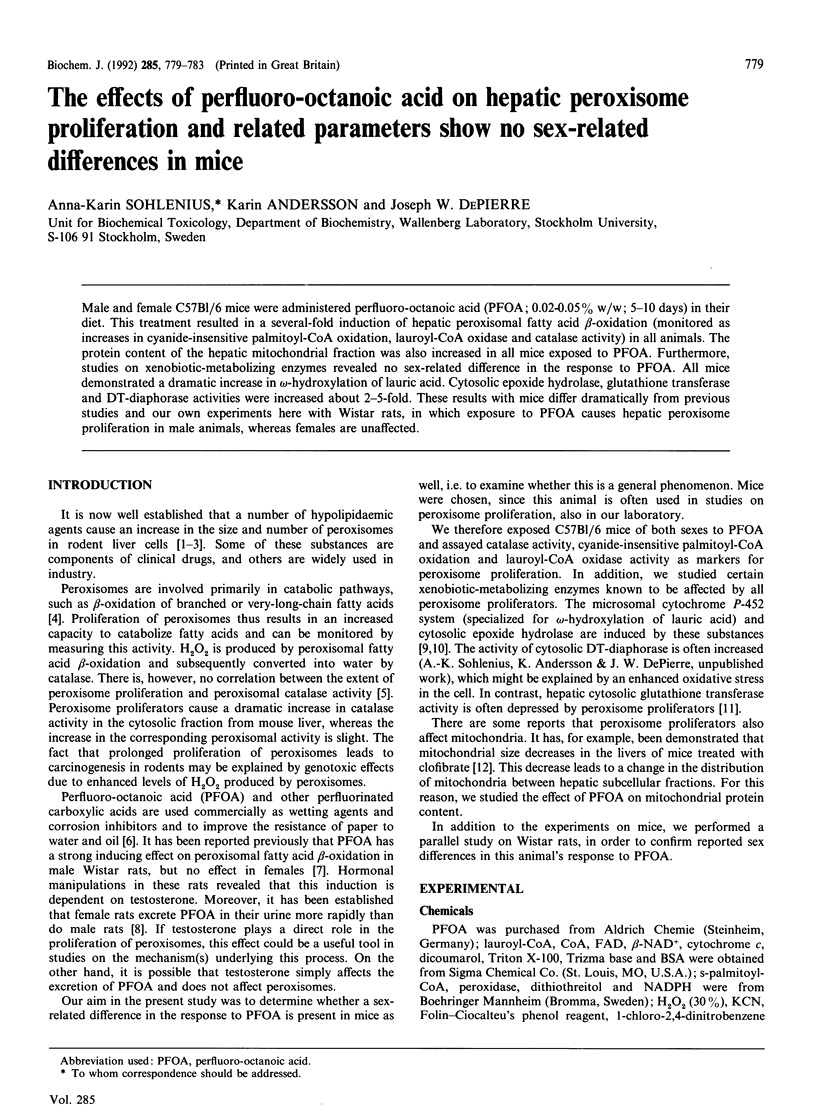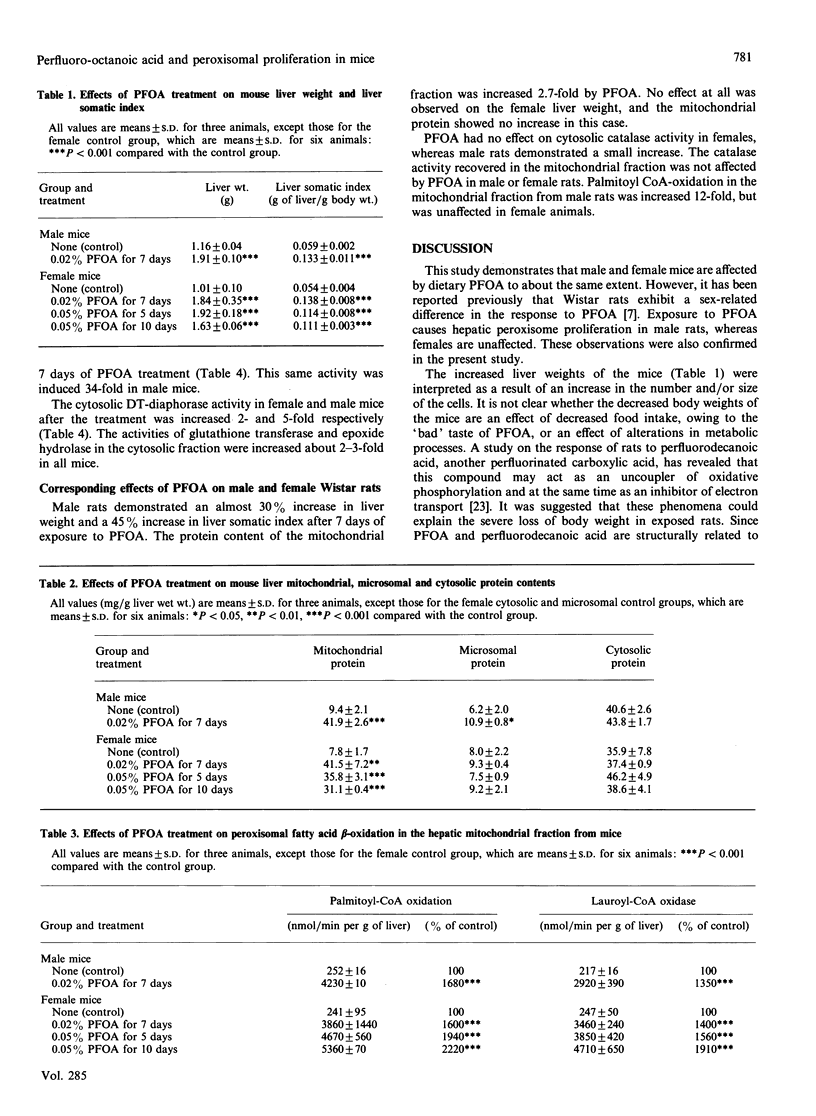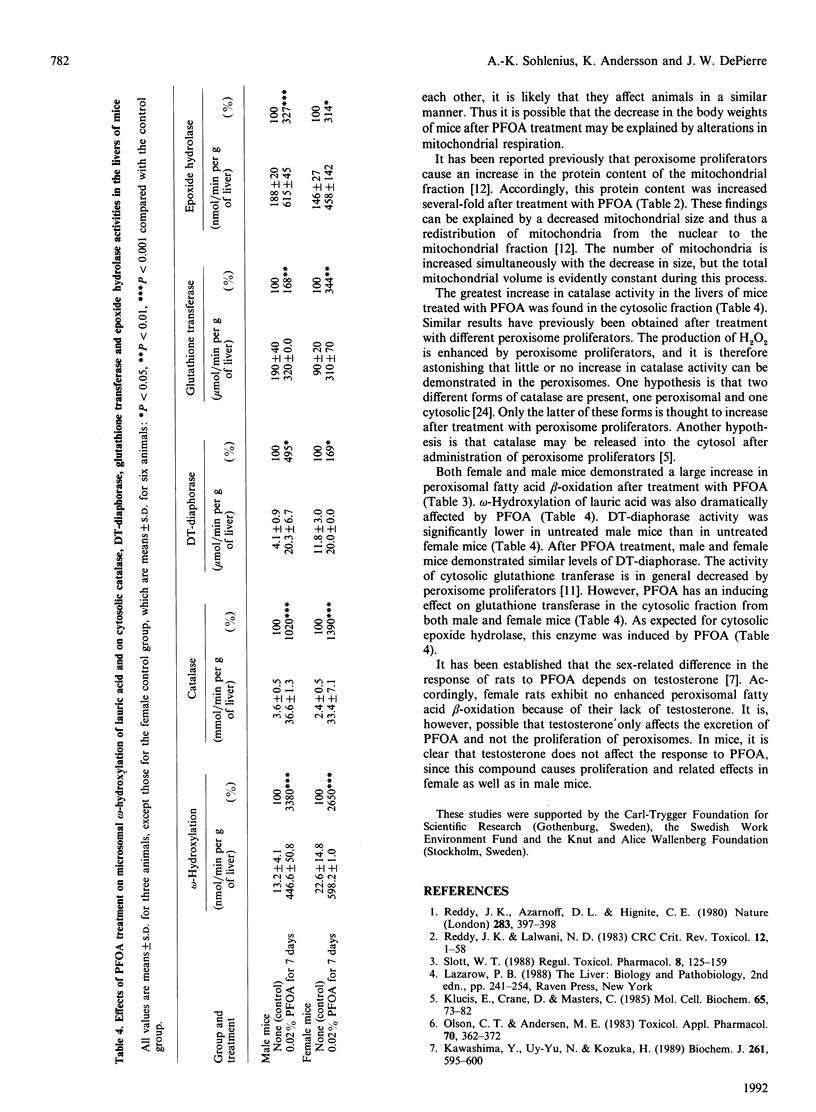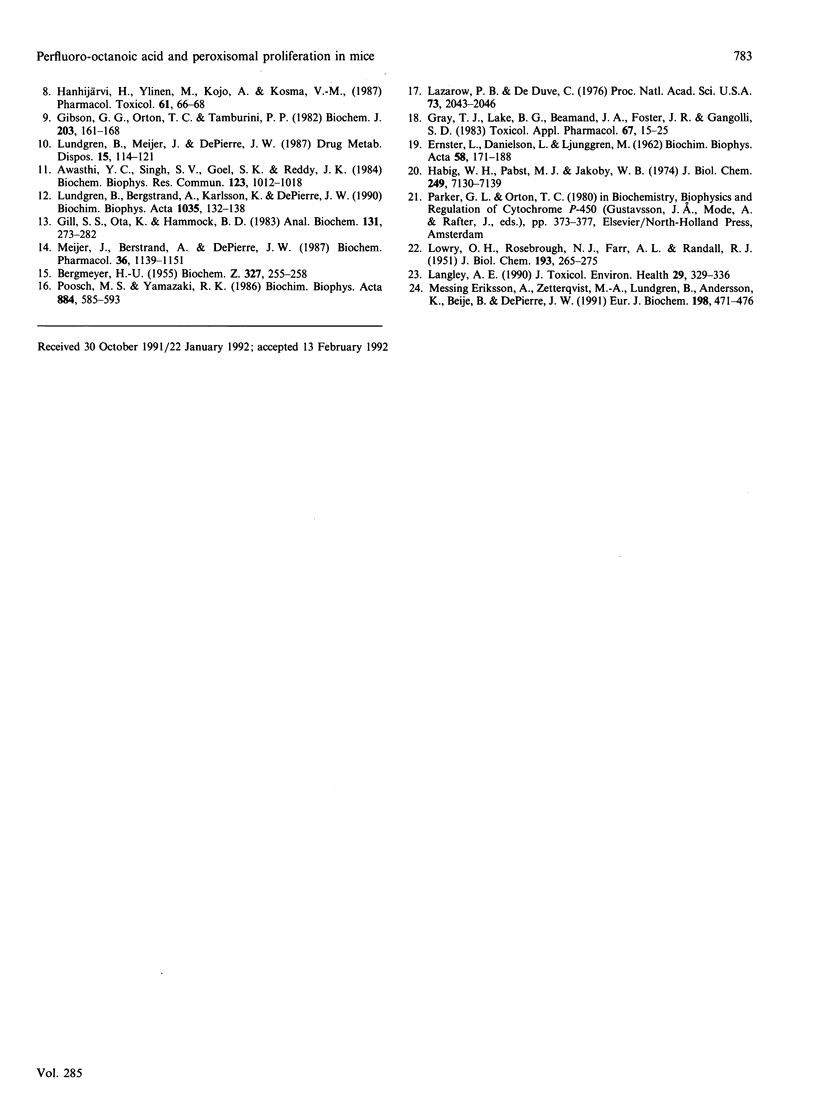Abstract
Male and female C57Bl/6 mice were administered perfluor-octanoic acid PFOA; 0.02-0.05% w/w; 5-10 days) in their diet. This treatment resulted in a several-fold induction of hepatic peroxisomal fatty acid beta-oxidation (monitored as increases in cyanide-insensitive palmitoyl-CoA oxidation, lauroyl-CoA oxidase and catalase activity) in all animals. The protein content of the hepatic mitochondrial fraction was also increased in all mice exposed to PFOA. Furthermore, studies on xenobiotic-metabolizing enzymes revealed no sex-related difference in the response to PFOA. All mice demonstrated a dramatic increase in omega-hydroxylation of lauric acid. Cytosolic epoxide hydrolase, glutathione transferase and DT-diaphorase activities were increased about 2-5-fold. These results with mice differ dramatically from previous studies and our own experiments here with Wistar rats, in which exposure to PFOA causes hepatic peroxisome proliferation in male animals, whereas females are unaffected.
Full text
PDF




Selected References
These references are in PubMed. This may not be the complete list of references from this article.
- Awasthi Y. C., Singh S. V., Goel S. K., Reddy J. K. Irreversible inhibition of hepatic glutathione S-transferase by ciprofibrate, a peroxisome proliferator. Biochem Biophys Res Commun. 1984 Sep 28;123(3):1012–1018. doi: 10.1016/s0006-291x(84)80234-x. [DOI] [PubMed] [Google Scholar]
- BERGMEYER H. U. Zur Messung von Katalase-Aktivitäten. Biochem Z. 1955;327(4):255–258. [PubMed] [Google Scholar]
- ERNSTER L., DANIELSON L., LJUNGGREN M. DT diaphorase. I. Purification from the soluble fraction of rat-liver cytoplasm, and properties. Biochim Biophys Acta. 1962 Apr 9;58:171–188. doi: 10.1016/0006-3002(62)90997-6. [DOI] [PubMed] [Google Scholar]
- Eriksson A. M., Zetterqvist M. A., Lundgren B., Andersson K., Beije B., DePierre J. W. Studies on the intracellular distributions of soluble epoxide hydrolase and of catalase by digitonin-permeabilization of hepatocytes isolated from control and clofibrate-treated mice. Eur J Biochem. 1991 Jun 1;198(2):471–476. doi: 10.1111/j.1432-1033.1991.tb16037.x. [DOI] [PubMed] [Google Scholar]
- Gibson G. G., Orton T. C., Tamburini P. P. Cytochrome P-450 induction by clofibrate. Purification and properties of a hepatic cytochrome P-450 relatively specific for the 12- and 11-hydroxylation of dodecanoic acid (lauric acid). Biochem J. 1982 Apr 1;203(1):161–168. doi: 10.1042/bj2030161. [DOI] [PMC free article] [PubMed] [Google Scholar]
- Gill S. S., Ota K., Hammock B. D. Radiometric assays for mammalian epoxide hydrolases and glutathione S-transferase. Anal Biochem. 1983 May;131(1):273–282. doi: 10.1016/0003-2697(83)90166-5. [DOI] [PubMed] [Google Scholar]
- Gray T. J., Lake B. G., Beamand J. A., Foster J. R., Gangolli S. D. Peroxisome proliferation in primary cultures of rat hepatocytes. Toxicol Appl Pharmacol. 1983 Jan;67(1):15–25. doi: 10.1016/0041-008x(83)90240-5. [DOI] [PubMed] [Google Scholar]
- Habig W. H., Pabst M. J., Jakoby W. B. Glutathione S-transferases. The first enzymatic step in mercapturic acid formation. J Biol Chem. 1974 Nov 25;249(22):7130–7139. [PubMed] [Google Scholar]
- Hanhijärvi H., Ylinen M., Kojo A., Kosma V. M. Elimination and toxicity of perfluorooctanoic acid during subchronic administration in the Wistar rat. Pharmacol Toxicol. 1987 Jul;61(1):66–68. doi: 10.1111/j.1600-0773.1987.tb01775.x. [DOI] [PubMed] [Google Scholar]
- Kawashima Y., Uy-Yu N., Kozuka H. Sex-related difference in the inductions by perfluoro-octanoic acid of peroxisomal beta-oxidation, microsomal 1-acylglycerophosphocholine acyltransferase and cytosolic long-chain acyl-CoA hydrolase in rat liver. Biochem J. 1989 Jul 15;261(2):595–600. doi: 10.1042/bj2610595. [DOI] [PMC free article] [PubMed] [Google Scholar]
- Klucis E., Crane D., Masters C. Sequential alterations in the micro-localization of catalase in mouse liver after treatment with hypolipidemic drugs. Mol Cell Biochem. 1984 Nov;65(1):73–82. doi: 10.1007/BF00226021. [DOI] [PubMed] [Google Scholar]
- LOWRY O. H., ROSEBROUGH N. J., FARR A. L., RANDALL R. J. Protein measurement with the Folin phenol reagent. J Biol Chem. 1951 Nov;193(1):265–275. [PubMed] [Google Scholar]
- Langley A. E. Effects of perfluoro-n-decanoic acid on the respiratory activity of isolated rat liver mitochondria. J Toxicol Environ Health. 1990;29(3):329–336. doi: 10.1080/15287399009531395. [DOI] [PubMed] [Google Scholar]
- Lazarow P. B., De Duve C. A fatty acyl-CoA oxidizing system in rat liver peroxisomes; enhancement by clofibrate, a hypolipidemic drug. Proc Natl Acad Sci U S A. 1976 Jun;73(6):2043–2046. doi: 10.1073/pnas.73.6.2043. [DOI] [PMC free article] [PubMed] [Google Scholar]
- Lundgren B., Bergstrand A., Karlsson K., DePierre J. W. Effects of dietary treatment with clofibrate, nafenopin or WY-14.643 on mitochondria and DNA in mouse liver. Biochim Biophys Acta. 1990 Aug 17;1035(2):132–138. doi: 10.1016/0304-4165(90)90107-8. [DOI] [PubMed] [Google Scholar]
- Lundgren B., Meijer J., DePierre J. W. Characterization of the induction of cytosolic and microsomal epoxide hydrolases by 2-ethylhexanoic acid in mouse liver. Drug Metab Dispos. 1987 Jan-Feb;15(1):114–121. [PubMed] [Google Scholar]
- Meijer J., Bergstrand A., DePierre J. W. Preparation and characterization of subcellular fractions from the liver of C57B1/6 mice, with special emphasis on their suitability for use in studies of epoxide hydrolase activities. Biochem Pharmacol. 1987 Apr 1;36(7):1139–1151. doi: 10.1016/0006-2952(87)90425-4. [DOI] [PubMed] [Google Scholar]
- Olson C. T., Andersen M. E. The acute toxicity of perfluorooctanoic and perfluorodecanoic acids in male rats and effects on tissue fatty acids. Toxicol Appl Pharmacol. 1983 Sep 30;70(3):362–372. doi: 10.1016/0041-008x(83)90154-0. [DOI] [PubMed] [Google Scholar]
- Poosch M. S., Yamazaki R. K. Determination of peroxisomal fatty acyl-CoA oxidase activity using a lauroyl-CoA-based fluorometric assay. Biochim Biophys Acta. 1986 Dec 10;884(3):585–593. doi: 10.1016/0304-4165(86)90211-4. [DOI] [PubMed] [Google Scholar]
- Reddy J. K., Azarnoff D. L., Hignite C. E. Hypolipidaemic hepatic peroxisome proliferators form a novel class of chemical carcinogens. Nature. 1980 Jan 24;283(5745):397–398. doi: 10.1038/283397a0. [DOI] [PubMed] [Google Scholar]
- Stott W. T. Chemically induced proliferation of peroxisomes: implications for risk assessment. Regul Toxicol Pharmacol. 1988 Jun;8(2):125–159. doi: 10.1016/0273-2300(88)90026-8. [DOI] [PubMed] [Google Scholar]


